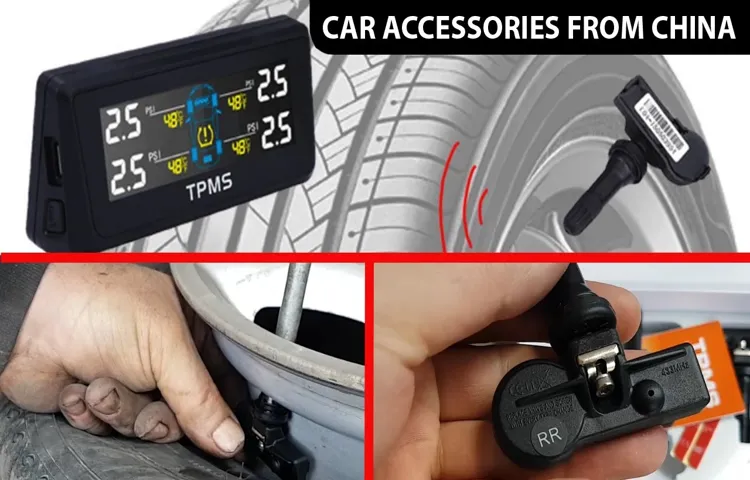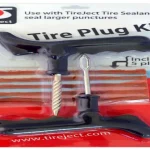Do you ever wonder how your car’s tire pressure monitoring system, or TPMS, works? These sensors play a vital role in keeping you safe on the road, alerting you when your tire pressure is low and preventing potential blowouts. But what happens when you need to replace a sensor or reprogram it after a tire change? In this blog post, we’ll delve into the nitty-gritty of how to program tire sensors, providing you with a step-by-step guide to get you back on the road with confidence. From understanding TPMS sensors to using programming tools, we’ve got you covered.
So, grab your tools and let’s get started!
Table of Contents
Understanding Tire Sensors
If you’ve ever had a new set of tires installed, chances are the mechanic talked to you about tire sensors. These sensors are an important safety feature that monitor tire pressure, alerting you when they need air. They work by sending signals to your car’s computer, which then displays a warning on your dashboard.
But how do you program these sensors? The process can vary depending on your car’s make and model, but generally involves placing the car into a programming mode and then using a special tool to activate each sensor. It’s important to follow the instructions carefully, as incorrect programming can lead to incorrect readings and potentially dangerous situations on the road. If you’re unsure about how to program your tire sensors, consult with a professional mechanic for assistance.
Types of Tire Sensors
One of the crucial components of a vehicle’s safety system is the tire sensors. These sensors are responsible for gathering important data about the condition of your tires, such as pressure and temperature, and alerting you when there is a potential issue. There are two main types of tire sensors: direct and indirect.
Direct tire sensors, also called TPMS sensors, are installed inside the tire and measure the air pressure using a radio frequency signal. Indirect sensors, on the other hand, use the ABS wheel sensors to determine the tire pressure by monitoring the rotation speeds of each tire. While both types of tire sensors have their advantages and drawbacks, they both play a vital role in ensuring the safety and performance of your vehicle.
It’s essential to understand how these sensors work so that you can keep your tires in optimal condition and minimize the risk of accidents on the road.

Working of Tire Sensors
Tire sensors are a crucial component of modern-day vehicles, designed to measure tire pressure and temperature in real-time. By monitoring tire health, these sensors help to prevent accidents caused by sudden tire blowouts or loss of traction. There are two types of sensors used in tire monitoring systems; direct and indirect.
Direct sensors measure pressure and temperature by providing real-time data, while indirect sensors calculate tire pressure based on wheel speed and other factors. Understanding how tire sensors work is essential for ensuring your safety on the road. It’s like having a personal assistant that alerts you when your tire needs attention, ensuring that you don’t overlook the health of your vehicle’s tires.
When the sensor detects a pressure drop or temperature increase outside of the recommended range, it notifies the driver through dash lights or audible warnings. By taking prompt action, you can avoid unexpected breakdowns and prolong the life of your tires. Overall, tire sensors are a critical tool for keeping your vehicle running smoothly and minimizing the risk of accidents on the road.
Preparing for Programming
Programming tire sensors can be a daunting task, but it’s not as complicated as you might think! Before beginning, it’s important to gather all of the required equipment. You’ll need a programming tool, typically available from your vehicle manufacturer or a tire shop, and a list of specific programming instructions for your vehicle’s make and model. It’s also a good idea to have replacement valve stems on hand, as they may need to be replaced during the process.
Once you have the necessary materials, start by placing the programming tool on the sensor, typically located near your tire’s valve stem. Follow the step-by-step instructions provided, which often require you to enter your vehicle’s make and model information. After programming the first sensor, continue repeating the process for each wheel until all sensors have been programmed successfully.
Once completed, it’s important to verify that each sensor is functioning correctly, which can be done by checking the sensor readings on your vehicle’s onboard computer. With these steps, you should be able to successfully program your tire sensors and ensure proper functioning and safety for your vehicle.
Things Required for Programming
Programming is a vast field that requires a specific set of skills and tools to become proficient. To prepare for programming, you need to have a strong foundation in math, logic, and problem-solving. You also need to have a good understanding of computer architecture and programming languages.
Having a high-level programming language, such as Python, in your skill set can be a significant advantage when getting started with programming. Additionally, having a solid grasp of software engineering principles and database management can help you succeed in this field. Another critical aspect of preparing for programming is having the right tools.
A reliable computer and text editor, such as Visual Studio Code or Atom, are essential for writing and running code. You may also need to have a compiler or interpreter to execute your code and test it. Many programmers also choose to use version control software, such as Git, to track changes and collaborate with others.
Finally, you need to have the right mindset for programming. This means being patient, detail-oriented, and persistent. Programming requires a lot of trial and error, so you need to be comfortable with trying multiple approaches to solve a problem.
You also need to be able to think logically and pay attention to details. Small errors in coding can cause significant problems, so you need to have a strong attention to detail to avoid mistakes. In summary, preparing for programming requires having a solid foundation in math and logic, a good understanding of computer architecture and programming languages, and the right tools, including a reliable computer, text editor, compiler or interpreter, and version control software.
Additionally, you need to have the right mindset and be patient, detail-oriented, and persistent to succeed in this field. By developing these skills and qualities, you can become a successful programmer and work on exciting projects that have a meaningful impact on society.
Checking Sensor Compatibility
Before you start programming your sensor, it’s important to make sure it’s compatible with your chosen platform. Compatibility issues are some of the most common problems when it comes to integrating sensors with programming platforms. To avoid such issues, it’s crucial to check the sensor’s specifications such as its output voltage, current, and communication protocol.
Additionally, checking the platform’s specifications is necessary to ensure that it supports the sensor you intend to use. For instance, if you plan to use a sensor with an I2C interface, make sure that the platform you’re working with supports I2C communication. By doing this, you’ll avoid spending time and effort troubleshooting compatibility problems that could have been prevented from the outset.
This step will save you from headaches, reduce development time, and ensure that your project is up and running in no time.
Programming the Sensors
If you’re wondering how to program tire sensors, the process is relatively straightforward. The first step is to acquire the appropriate software and hardware required for your car’s specific brand of tire sensor. Once you have the tools needed, connect the sensor to a computer and launch the software.
From here, you’ll be able to configure the sensor’s settings such as temperature thresholds and pressure alerts. It’s important to ensure that the sensor is calibrated correctly for accurate readings, so be sure to follow the manufacturer’s instructions carefully. Once you’ve programmed the sensor, you can test it out by driving your car and monitoring the readings.
Keep in mind that tire sensors are a safety feature and can prevent accidents on the road, so it’s essential to make sure they’re functioning correctly. With a little bit of know-how, programming tire sensors doesn’t have to be a daunting task.
Selecting Programming Mode
When programming sensors, one of the first decisions to make is selecting the programming mode. This decision can have a major impact on the overall functionality of the sensor and how it interacts with other components of the system. One of the most common modes is event-driven programming, which allows the sensor to react to specific events and triggers.
This can be very useful for applications that require real-time responses or need to monitor a particular parameter or condition. Another option is continuous programming, which constantly monitors the sensor data and provides feedback based on predefined thresholds or criteria. Both of these approaches have their own advantages and disadvantages, and the choice ultimately depends on the specific needs of the application.
It’s important to carefully consider all options and select the mode that will offer the best performance, reliability, and ease of use for your particular project.
Entering Sensor ID
Programming sensors can be a daunting process, especially when it comes to entering the sensor ID. However, it is a crucial step that must be done correctly to ensure accurate data collection. The sensor ID is a unique identifier for each sensor and is used to distinguish between different sensors when transmitting data.
It is typically a combination of letters and numbers and can be found on the sensor itself or its accompanying documentation. To enter the sensor ID, you will need to use the programming interface or software provided by the manufacturer. The process varies depending on the type of sensor and programming interface used.
Some sensors may require manual entry of the sensor ID, while others may have an automatic detection feature. It is important to follow the manufacturer’s instructions carefully to ensure proper programming and operation of the sensor. Inaccurate entry of the sensor ID can lead to invalid data readings and cause issues with data analysis.
Therefore, it is essential to double-check the sensor ID before entering it into the programming interface. It is also recommended to keep a record of each sensor and its corresponding ID to ensure proper organization and easy maintenance. In summary, entering the sensor ID is a critical step in programming sensors.
It ensures accurate and reliable data collection and prevents errors in data analysis. Always follow the manufacturer’s instructions carefully and double-check the sensor ID to avoid any issues. Keep records of each sensor and its corresponding ID for proper organization and maintenance.
Learning Sensor Position
When it comes to programming sensors, the first thing you need to do is determine their position. Accurate sensor placement is essential for gathering accurate data. There are different types of sensors such as infrared, ultrasonic, and proximity sensors, and each has its own programming considerations.
For instance, if you’re programming a proximity sensor, it’s important to note that it operates on the principle of detecting the presence of an object. Therefore, you need to consider its range, angle of detection, and any interfering factors that could affect its readings. Similarly, programming an infrared sensor requires identifying its field of view and ensuring that it’s positioned correctly to detect the desired temperature readings.
By understanding the technical specifications of the sensor and programming it accordingly, you can ensure that it accurately captures the data you need.
Verifying Sensor Activation
When it comes to programming the sensors, one of the most crucial aspects is verifying their activation. After all, there’s no point in collecting data from a sensor that isn’t working properly. The first step in verifying sensor activation is to ensure that the sensor is properly connected and powered.
Once that’s done, the sensor needs to be calibrated to ensure that it’s providing accurate readings. This involves setting the sensor’s minimum and maximum values so that it can accurately detect changes in the environment. Finally, the sensor needs to be tested to make sure that it’s working correctly.
This can be done by exposing the sensor to different environmental conditions and verifying that it’s providing accurate readings. By following these steps, you can be confident that your sensors are working correctly and providing the data you need to make informed decisions.
Tips for Tire Sensor Programming
If you’ve ever had to replace your car’s tire sensors, you know how overwhelming it can feel. Fortunately, programming tire sensors is a relatively straightforward process that doesn’t take much time or effort. The first step is to determine the type of sensor your car uses.
Some sensors require a special tool to program, while others can be programmed manually by following a specific sequence of steps. Once you know what type of sensor you’re working with, you can begin the programming process. This typically involves accessing the car’s computer system and following the instructions provided in your owner’s manual.
It’s important to note that some sensors require recalibration after they’ve been programmed, so be sure to follow the manufacturer’s instructions carefully. With a little patience and attention to detail, you can successfully program tire sensors and get back on the road with ease.
Best Practices
When it comes to programming tire sensors, it’s essential to follow best practices to ensure proper functionality and accuracy. Here are some tips to keep in mind. First, make sure the sensor is compatible with the vehicle and the tool being used for programming.
It’s also crucial to follow the manufacturer’s instructions carefully, including the correct procedures for initiating and programming the sensors. Additionally, verify that the sensor ID numbers match the vehicle’s approved list to avoid any issues. Finally, make sure to perform a sensor relearn procedure after programming to ensure the sensors are correctly recognized by the vehicle’s system.
By following these best practices, you can ensure the correct programming of tire sensors for optimal performance.
Common Mistakes to Avoid
When it comes to programming your tire sensor, there are a few common mistakes that you should avoid. First, make sure that you select the correct make and model of your vehicle, and input the correct tire pressure specifications. Failure to input accurate information can lead to inaccurate readings and unnecessary warnings.
Another mistake to avoid is forgetting to reset your sensors after you have changed your tires. Failure to reset your sensors can result in the system picking up the wrong information, and could lead to false alarms. Finally, be sure to follow the manufacturer’s instructions carefully, and take your time when programming your sensors.
Rushing through the process can increase the likelihood of errors and result in a less accurate tire pressure monitoring system. By following these tips, you can help ensure that your tire pressure monitoring system is accurate and effective.
Conclusion
In conclusion, programming tire sensors may seem like a daunting task, but with a little bit of knowledge and some patience, anyone can do it. Just remember to read the instructions carefully, follow the proper procedures, and don’t give up if it doesn’t work the first time. And who knows, maybe the next time you have to change your tires, you’ll impress your friends and colleagues with your newfound programming skills.
Happy tinkering!”
FAQs
What are tire sensors?
Tire sensors are devices designed to monitor the air pressure and temperature in a vehicle’s tires.
How do tire sensors work?
Tire sensors typically use a pressure sensor mounted inside each tire to measure the pressure. They can transmit this information wirelessly to a monitor on the dashboard.
How important are tire sensors?
Tire sensors are crucial in ensuring safety while driving. Proper inflation of tires decreases the chances of accidents while driving.
What are the different types of tire sensors available?
There are two types of tire sensors available in the market. Direct TPMS, which have sensors inside the tire, and Indirect TPMS, which uses wheel speed sensors to calculate tire pressure.
Can tire sensors be replaced?
Yes, tire sensors can be replaced if they malfunction or fail.
Is it necessary to replace tire sensors?
If tire sensors are not working properly or giving incorrect readings, they must be replaced to ensure safety.
How can I program my tire sensors?
Tire sensors can be usually programmed using a handheld programmer tool or through the vehicle’s onboard computer system. It is best to consult the vehicle’s owner manual for specific instructions.



